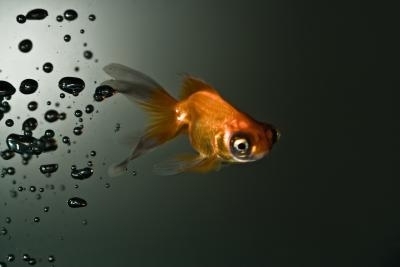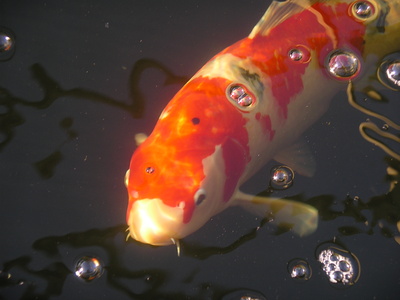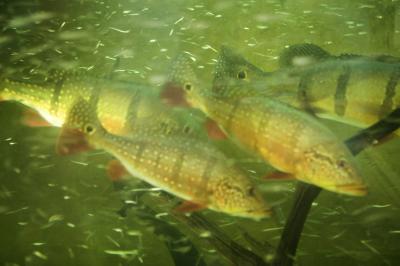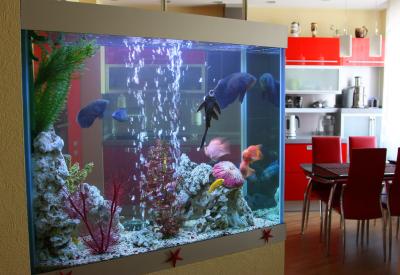

A member of the cichlid family, freshwater angelfish (Pterophyllum scalare) make a attractive showpiece to any fish tank. These fish attract attention for their looks and their individual personalities. Spend enough time watching angelfish in your freshwater tank and you’ll soon learn that each one is unique. This in addition to their easy care and hardy nature, has made them one of the most popular aquarium fish. But learn more facts about angelfish and you’ll find that there’s more you can do to keep them in a more natural environment that allows them to truly thrive and live a full lifespan of 10 years of more.
Facts About Angelfish Natural History
Like most other cichlid species, freshwater angelfish are native to tropical rivers, specifically the Amazon and its tributaries. Their native range is vast and extends “from Peru to the mouth of the Amazon River at Belem,” reports 500 Freshwater Aquarium Fish. This water is murky with a high concentration of peat as a result of the streams feeding the river running through peat swamps and marshes before dumping into the Amazon River. Those steams do not, however, add high concentrations of minerals to the water.
Facts About Angelfish Care
Tank Size
For angelfish, the height of the tank is just as important as the width. These are active fish and they are tall fish if you include the height of their exceptionally long fins. Larger individuals can reach almost a foot in height. The smallest tank size appropriate for this species would be 30 gallons, which could house two freshwater angelfish. These are not fish for a 10-gallon fish tank.
Water Conditions
Water temperatures should range from 70 to 85 degrees. But they will often hang out near the heater if temperatures drop below 75 degrees. To breed, angelfish prefer acidic conditions with a pH range of 6.5 to 6.8, but they tolerate pH ranges of 6.5 to 7.2 reports the Greater Chicago Cichlid Association. They prefer low to medium water hardness, much like their native Amazonian waters.
Angelfish will also appreciate a blackwater environment. Blackwater refers to tank water that is slightly brown from the addition of peat, which mimics the natural habitat of these cichlid angelfish. You can add peat moss to the filter or tank or use blackwater peat extract found at most fish retailers to accomplish this. Peat will also help soften the water and increase its acidity slightly, all conditions favored by freshwater angelfish.
Feeding
Since they are an omnivorous fish, feeding is easy. They readily consume fish flakes, frozen or live brine shrimp, frozen bloodworms, and even fresh produce. And sometime they will consume other fish and plants in the tank.
Compatibility with Other Fish Species
These are a community fish and mostly peaceful species that can be housed with many other common community fish species such as tetras and guppies. However, they are also slightly aggressive at times and will pick on smaller fish if the tank is overcrowded or they have eggs to protect. They will also eat fish that they can swallow whole. It may surprise you just how large of a fish these cichlids can swallow whole, especially if you bring home some new neon tetras to add to your tank.
Author Joseph S. Levine notes in The Complete Fishkeeper that some scarlare angelfish will fight with each other. Raising angelfish together seems to reduce this behavior.
 Cold-Water Fish Types
Cold-Water Fish Types
Cold-Water Fish
Cold-Water Fish Types
Cold-Water Fish Types
Cold-Water Fish
 Life Span of Female Betta Fish Vs. Male
Life Span of Female Betta Fish Vs. Male
Life Span of Female Betta Fish Vs. Male
Life Span of Female Betta Fish Vs. Male
 Causes of Pond Fish Sitting on the Bottom of the Pond and Refusing to Eat
Causes of Pond Fish Sitting on the Bottom of t
Causes of Pond Fish Sitting on the Bottom of the Pond and Refusing to Eat
Causes of Pond Fish Sitting on the Bottom of t
 Cloudy Eyes on Aquarium Fish
Cloudy Eyes on Aquarium Fish
Cloudy Ey
Cloudy Eyes on Aquarium Fish
Cloudy Eyes on Aquarium Fish
Cloudy Ey
 List of Aggressive Tropical Freshwater Fish
List of Aggressive Tropical Freshwater Fish
List of Aggressive Tropical Freshwater Fish
List of Aggressive Tropical Freshwater Fish
Copyright © 2005-2016 Pet Information All Rights Reserved
Contact us: www162date@outlook.com